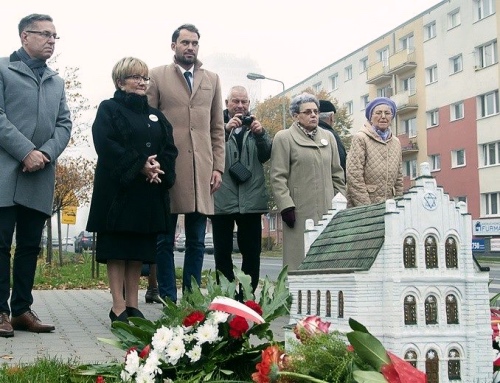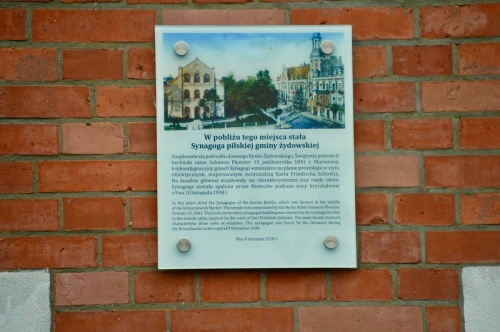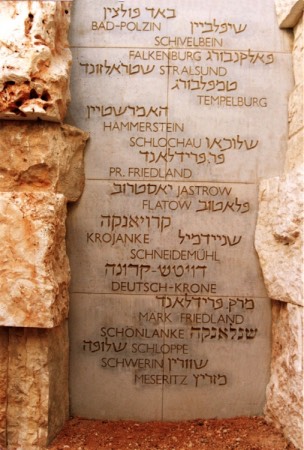|
Welcome to the memorial website dedicated to the history of the former Jewish community of Schneidemühl / Piła (Poland) The following pages are in memory of this Jewish community that existed for 300 years in the heart of Wielkopolska, Great Poland, where the culture of Ashkenaz had flourished for centuries, the area that later became the Prussian province of Posen. We remember the men, women and children of the community who became ensnared in the Holocaust and did not survive.  - their names are not forgotten -
(Photo courtesy František Bányai, Prague) The venerable synagogue of Schneidemühl, consecrated on 15 October 1841, was blessed by Rabbi Plessner with these words: “May this house serve also as a monument to the unforgettable man and father of our country, the late King Friedrich Wilhelm III.” During the pogrom night of 9/10 November 1938, (an event the Nazis mockingly called 'Kristallnacht,') this House of God—a government-protected monument in the center of Wilhelmsplatz— was desecrated, burnt and destroyed by notorious Nazi elements of Schneidemühl. In a solemn ceremony on 8 November 2018 - eighty years after the synagogue's destruction - dignitaries from the city council of Piła found it in their hearts to gather where the synagogue had stood for nearly one hundred years, joined by representatives from the Poznan Jewish community, to commemorate the tragic events of 1938  Symbolically, a replica of the synagogue had been created for the occasion by the local artist Marek Brose-Kwasigroch  Unveiling .a memorial plaque on the wall of the city's old Royal Post Office, opposite of the locale where the synagogue once stood - reads: "In this place stood the synagogue of the Jewish kehila, which was located in the middle of the former Jewish Market. The Temple was consecrated by the Berlin Rabbi Salomon Plessner, October 15, 1841. The brick, three-story synagogue building was erected on the rectangular plan in the eclectic style, inspired by the work of Karl Friedrich Schinkel. The main facade featured characteristic three rows of windows. The synagogue was burnt by the Germans during the Kristallnacht on the night of 9 November 1938." . "Piła, 8 listopada 2018 r." * * * . Five hundred years ago this town was known to Polish-speaking people by such names as Pyła or Piła. The early Low German-speaking settlers liked to call their town Snyde-Mole, Schnyde-Möhle, or Schneyde-Mühle. * Schneidemühl was the German name that was given to the Polish town of Piła by the Prussians in 1772, after their annexation of the area. The town’s Polish name Piła — derived from the Polish root word 'pila,' meaning ‘saw’ — referred to a place where rushing water powered a device used for sawing wood. The word Schneidemühl is a literal translation from Polish to German. Piła, as a kehila, was never regarded by its Jewish community as a shtetl, the Jews of the area simply wrote the name of their town פילה in Hebrew letters. From the late 1700s until 1940, Schneidemühl was the home of seven
generations of this webmaster's ancestors, the Simonstein
family.
(Photo courtesy Bella Rothenberg, Kfar
Giladi, Israel) * * *  . 'Valley of the Destroyed Communities' at Yad Vashem, on the Mount of Remembrance in Israel. The community of Schneidemühl — one of 4,500 destroyed communities — is commemorated here in stone, together with others of Pomerania, Posen and West Prussia. * * *
Links to external websites are provided in good faith and for information only. Disclaimer: no responsibility for materials contained in any website linked from this site. Last Update - 21 October 2019 Please direct any correspondence to: aurifex@sympatico.ca KehilaLinks is a project of JewishGen, Inc., which aims to provide a place where anyone with an interest in a place where Jews have lived to commemorate that place. This is accomplished by creating an individual web page for that place with information, pictures, databases, and links to sites that provide additional information on that place. KehilaLinks is not confined to Ashkenazim (descendants of eastern European Jews); it is open to Sephardim (descendants of Jews from Spain and Portugal), Mizrachim (Jews from Asia) and Jews from other places as well. JewishGen Home Page KehilaLinks Directory This site is hosted at no cost by JewishGen, Inc., the Home of Jewish Genealogy and may be linked to. However, no part or text of this site may be copied in any way without the webmaster's permission. If you have been aided in your research by this site and wish to further our mission of preserving our history for future generations, your JewishGen-erosity is greatly appreciated. |